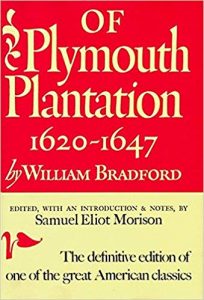
Samuel Eliot Morison’s 1952 Edition Is a Great American Treasure
Be grateful for good, knowledgeable, and insightful editors who turn old, difficult-to-decipher, but invaluable manuscripts into versions we 21st-Century moderns can read and enjoy. I have the 1993 hardback copy of the esteemed professor’s edition, with dust jacket, heavily marked up in many places. In his preface, Admiral Morison tells us that:
It is this story, told by a great human being, that has made the Pilgrim Fathers in a sense the spiritual ancestors of all Americans, all pioneers. They were equal to any standard of excellence known to history. Their range was narrow, but within it they were supreme. (pg. xii)
Of Plymouth Plantation (originally spelled Plimouth) is a firsthand, historical record of the English settlement of Plymouth, Massachusetts, established with great sacrifice by the passengers of the Mayflower and those who later joined them. It is both the official and occasionally personal journal of the man who became their governor.
Not to be neglected by an interested reader, editor Morison’s Preface imparts insight and his Introduction includes a background of Governor Bradford and the rather amazing history of the almost-lost, original Plymouth manuscript, a loss difficult to imagine. The editor’s extensive Notes provide explanations, context, background, references, and comments, appearing on almost every page to guide us through some 30 years of reasonings, decisions, preparations, obstacles, journey, struggles, life, love, families, celebrations, loss, wars, disease, death, but always faith ~ and the foundation of a new country.
The edition also includes letters, official documents, and a Mayflower passenger list.
Who Was William Bradford?
In this edition, you will engage two “great human beings” ~ the Plymouth leader, and the historian. First, meet the author of the original manuscript.
William Bradford was born in Yorkshire, England, in 1590, of yeoman farmer stock. By the age of 12, he was devoted to the reading of his Geneva Bible. Even when the King James version appeared in 1611, Bradford continued with his Geneva. “When still a lad,” he joined the home-church congregation of Separatist “Puritan” William Brewster in the village of Scrooby, despite the “wrath” and “scoff” of family and neighbors. He removed to the Netherlands with the persecuted group, became a weaver, learned Dutch and a bit of Latin and Hebrew, collected a “fair-sized library” (which made it to the New World), married and had a son named John.
When the congregation determined to leave the Netherlands and hazard the journey to America, they bought the ship Speedwell and sailed to meet the rest of the adventurers in England. Just a few years old, John was left behind in England for safety’s sake with plans to come later. The group (after false starts) abandoned the Speedwell and finally embarked from Plymouth (England) on the Mayflower. It is believed by many, including Morison, that the heartbreak of leaving her young son, plus the heart-sinking bleakness of the first views of Cape Cod, drove Bradford’s wife Dorothy to “fall” overboard and drown in Massachusetts Bay.
One of the many deathly ill in those early months in America, Bradford survived to be elected unanimously to take the governorship of Plymouth colony when John Carver died in May, 1621. Bradford had only recently turned 31. In Cotton Mather’s 1702 biography of Bradford, the Puritan minister wrote that “the difficulties whereof were such that, if he [Bradford] had not been a person of more than ordinary piety, wisdom and courage, he must have sunk under them.” (quoted in Morison’s Introduction, pg. xxiv; see Mather’s biography in Caleb Johnson’s edition of Of Plymouth Plantation)
Two ships arrived in the summer of 1623, carrying some of the Leyden congregation who had remained behind in England (but not young John). Recently widowed, Anne Southworth arrived on the Anne with her two sons. She married Bradford in August and they had three more children. Really quick courtship? They knew one another from past years. More important, the state of marriage was diligently pursued by these believers for help, companionship, joy, and, of course, children.
Re-elected governor almost every year, Bradford served as the group’s “principal leader” until his death in May, 1657, at the age of 67. Anne lived until 1670.
Who Was Samuel Eliot Morison?
Morison was born in Boston in 1887. His mother, an Eliot, bequeathed him New England Yankee roots from the 1660s. He learned sailing and horsemanship and earned his Ph.D. from Harvard where he taught for 40 years. He has a colorful life story. He wrote The Maritime History of Massachusetts, 1783-1860 in 1921. He is well known for his biography of Christopher Columbus, Admiral of the Ocean Sea, 1942, for which he sailed the routes of Columbus in a 45-foot ketch, from Europe to the Caribbean, and along South and Central America. He wrote biographies of John Paul Jones and Champlain and various works on Plymouth and the Pilgrims, to name just a few. His list of books is long. His Oxford History of the American People and The Growth of the American Republic were college staples. I also have his European Discovery of America, the Northern Voyages.
He went to sea during World War II, commissioned by the President as a lieutenant commander in the Naval Reserve to write a history of the Navy’s wartime operations. It resulted in 15 volumes, and Morison was promoted to a rear admiral. He collected two Pulitzers, the Legion of Merit, the Presidential Medal of Freedom (1964), and other awards and honors.
He also wrote History as a Literary Art: An Appeal to Young Historians (1946) and it doesn’t take much reading of Morison to discover and appreciate just how clearly, easily, and vividly he wrote, with meticulous research, care, knowledge, and experience. If you enjoy history and you don’t know Morison, you should. [See Britannica.com and Wikipedia]

